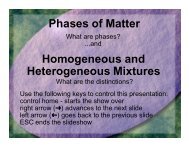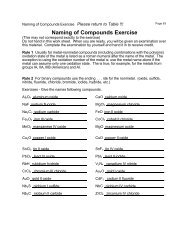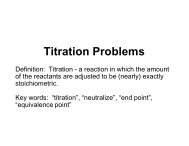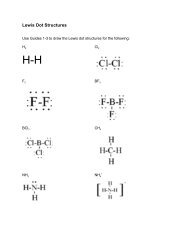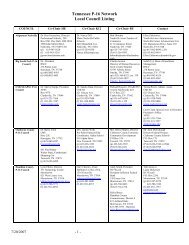2006-2008 Catalog - Roane State Community College
2006-2008 Catalog - Roane State Community College
2006-2008 Catalog - Roane State Community College
You also want an ePaper? Increase the reach of your titles
YUMPU automatically turns print PDFs into web optimized ePapers that Google loves.
7111-<strong>Roane</strong>StCommColl 6/16/06 2:58 PM Page 219<br />
ROANE STATE COMMUNITY COLLEGE 219<br />
GIS 105—Computer Cartography. . . . . . . . . . . . . . . . . . . . . . . . . . . . . . . . 3 Credits<br />
An introduction to the properties, uses, symbology design and computer production of maps.<br />
Covers the use of maps, aerial photographs and satellite imaging in geographical analysis.<br />
GIS 110—Geographic Database Technology . . . . . . . . . . . . . . . . . . . . . . . 3 Credits<br />
Geographic Information Systems (GIS) need access to a great variety of data to be of any value<br />
for decision making. This introductory course will cover major aspects of capturing, manipulating,<br />
and using geographic and related data. Topics include hierarchical vs. flat-file databases,<br />
data tables, geographic objects and attributes, relational databases, geographic data organization,<br />
data conversions, import-export, and data quality assessment. The student will learn to<br />
construct queries using SQL and query-by-example tools to answer simple and more complex<br />
problems. Data used includes TIGER/Line, DLG/DEM. DWG and ASCII. Database software<br />
used includes FoxPro, Access, MapInfo, ArcView, Integraph, and Maptitude plus various conversion<br />
software. Sp<br />
GIS 210—Global Positioning Systems and Digital Imagery . . . . . . . . . . . 3 Credits<br />
Using Global Positioning System (GPS) technology, this course will introduce topics of data<br />
capture (including scanning), editing, registration and rectification to provide an image for the<br />
extraction of geographic data such as property boundaries, streets, streams and structures. Uses<br />
of GPS in this course are to provide reference points for registering and rectification of images,<br />
verifying and correcting map data as well as creating real-time maps with the use of laptop<br />
computers.<br />
GIS 211—Internet Mapping Applications. . . . . . . . . . . . . . . . . . . . . . . . . . 3 Credits<br />
This course provides the foundation for distributing high-end GIS and mapping services via the<br />
internet. Students will learn how to design web based applications for integrating local and internet<br />
spatial data sources for query, display and analysis in a user friendly web browser.<br />
GIS 220—GIS Network and Demographic Applications. . . . . . . . . . . . . . 3 Credits<br />
The student will focus on developing a coherent framework for using the vast quantities of data<br />
made available by government and other sources along with his/her own data. The student will<br />
explore multiple views of a single issue or set of information by looking for new possibilities.<br />
(Prerequisites: GIS 101 and GIS 110) Sp<br />
GIS 230—GIS Project Management . . . . . . . . . . . . . . . . . . . . . . . . . . . . . . 3 Credits<br />
The student will focus on developing a coherent framework for using the vast quantities of data<br />
made available by government and other sources along with his/her own data. The student will<br />
explore multiple views of a single issue or set of information by looking for new possibilities.<br />
Learning outcomes include gaining and enhancing the ability to effectively match data and task<br />
appropriately and to identify appropriate types and sources of information needed to solve a<br />
problem. (Prerequisites: GIS 101 and GIS 110) Sp<br />
GIS 250-259—Seminar in Geographic Info Systems1-4 Credits<br />
Special topics in GIS. Check with your advisor for courses available each semester.<br />
GIS 290—Directed Research Project. . . . . . . . . . . . . . . . . . . . . . . . . . . . . . 4 Credits<br />
This capstone course will consolidate the student’s learning experiences in geographic information<br />
systems technology. Students will develop and complete an original, comprehensive<br />
project that encompasses geographic and computer mapping fundamentals learned in previous<br />
courses. (Prerequisite: Permission of the instructor) Su<br />
GEOGRAPHY<br />
Geography is a subject which in its broadest sense studies the earth-atmosphere system<br />
and human activities therein. As such, geography provides an unusual blend of social<br />
science and natural science. Prospective students should note that the 3-credit-hour<br />
courses in geography generally are classified as social science credits. The 4-credithour<br />
sequence (GEOG 1040, 1050, Geography of the Natural Environmental I, II) fulfill<br />
the natural/physical science requirements in most liberal arts programs.<br />
Course Descriptions




